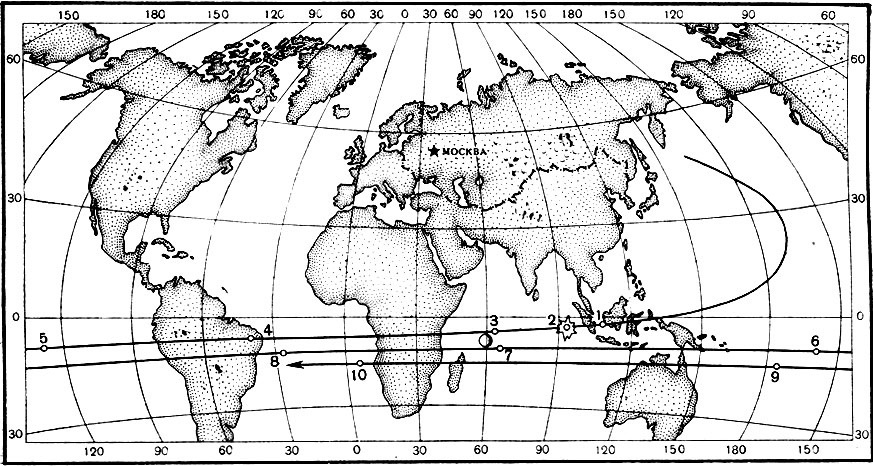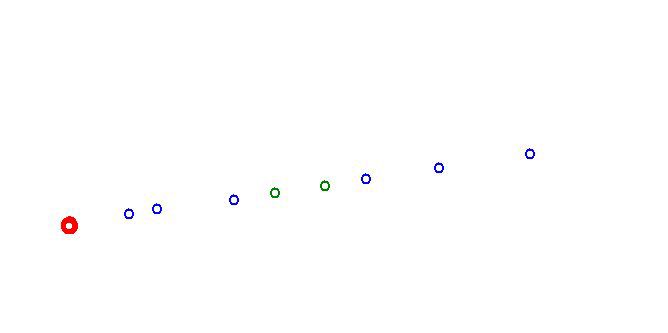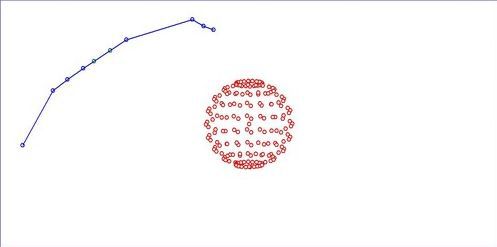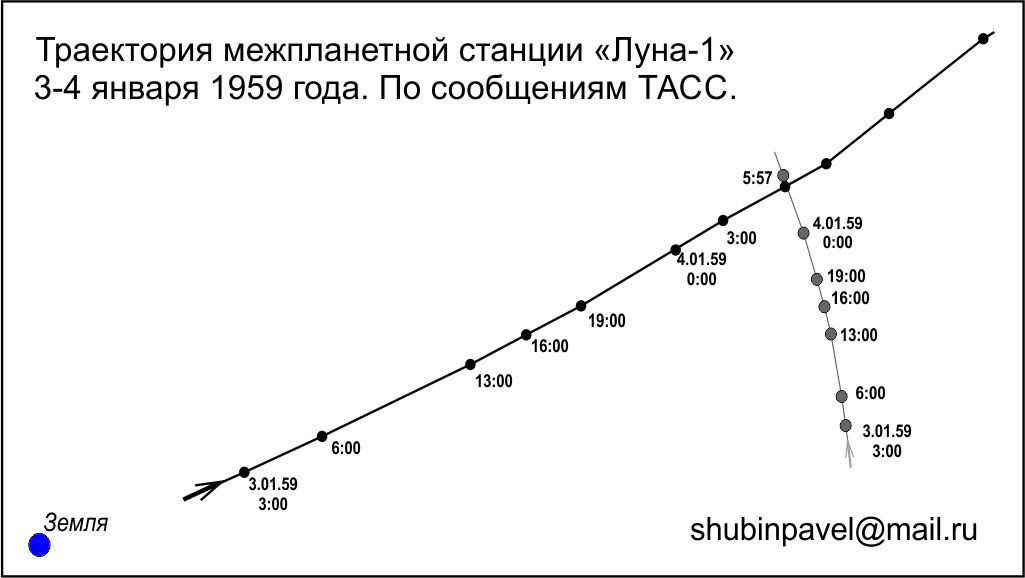Path "Moon 1"
On January 2, 1959, the station Luna-1 departed. It was the first station to reach the second space velocity and the first station to fly past the moon. According to data from her instruments, it was shown that the Moon does not have a magnetic field and the solar wind was discovered. Even the fact that she did not hit the moon because of an error is now perceived as a plus. Because of this, it is in its entirety and safety now flies in its orbit between the Earth and Mars.
Well, I decided to try to restore the trajectory of its flight on archival materials.

')
The scientists and engineers who prepared the TASS reports clearly ran into an unexpected problem. How to specify the station coordinates during the flight? Her flight was covered in great detail and it was necessary to indicate the coordinates in such a way that any person could find in the sky a point where the earth's envoy to space is located. At astronomers, it is customary to show the coordinates for right ascension and declination (analogue of latitude and longitude on Earth), but here they did not fit well. They are good only for specifying very, very distant objects. As a result, it was decided to tie the coordinates not to the sky, but to the Earth. And indicate over which of the points the station will be at a given time and at what height.
To control the trajectory and determine the coordinates used an automated system designed to determine the trajectory of ballistic missiles.
The scan to the surface of the earth looked like this:

And if you collect all the information from the TASS message, you can select such points
January 3 at
3 hours: 3 degrees 12 minutes S and 108 degrees E 100,000 km from the Earth [1]
6 hours: 4 degrees 30 minutes S and 63.5 degrees E. 137,000 km from the Earth [3]
13 hours: 7 degrees 33 minutes S and 40 degrees W. 209,000 km from the Earth [4]
16 hours: 8 degrees 20 minutes S and 86 (85) degrees W. 237,000 km from the Earth
19 hours 8 degrees 57 minutes S and 131 (130) degrees W. d 265,000 km from the Earth [5]
21 hours 9 degrees 18 minutes S and 160 degrees W. 284,000 km from the Earth [6]
January 4th at
0 hours: 9 degrees 45 minutes S and 155 degrees E 311 000 km from the Earth
3 hours: 10 degrees 7 minutes S and 110 degrees Eh 336 600 km from the Earth
At 5 hours and 57 minutes, the rocket passed at a minimum distance from the Moon (5-6 thousand km) and became a satellite of the Sun [7]. Then TASS began to publish its coordinates in astronomical coordinates. Although some of the coordinates, as can be seen in the diagram, were recalculated in the terrestrial
On January 5 at 10 o'clock her batteries sat down and communication with her ceased.
Few comments. In square brackets marked numbers of similar points on the map of the Earth.
In two parentheses are marked more accurate coordinates. Just by analyzing the data, it turned out that they noticeably stand out from the general trajectory. It seems that in the TASS message there was an error of 1 degree west longitude.
Knowing this data and the speed of rotation of the Earth, you can rebuild them into three-dimensional coordinates, and then visualize the trajectory.
I got such a trajectory

The flight path is very large and I had to “play” for a long time with the coefficients in order to show the curvature of the path. It turned out this picture

The second point on this scheme noticeably knocked out. I just tried to take into account also the moment of launching the artificial sodium comet. Unfortunately, due to cloud cover over the territory of the USSR at that moment (it was photographed at only one observatory), and also due to the fact that only 10% of all sodium was sprayed, the coordinates are not very accurate.
Having a little processed the received result, I drew such scheme:

In general, it is quite clearly seen how the station and the moon move to the place of their meeting. And if you carefully study the trajectory of "Luna-1" can be seen and bend after meeting her with the moon. The gravitational field of the moon has sufficiently changed its trajectory, so that it can be noticed even on such an approximate scheme.
Well, I decided to try to restore the trajectory of its flight on archival materials.

')
The scientists and engineers who prepared the TASS reports clearly ran into an unexpected problem. How to specify the station coordinates during the flight? Her flight was covered in great detail and it was necessary to indicate the coordinates in such a way that any person could find in the sky a point where the earth's envoy to space is located. At astronomers, it is customary to show the coordinates for right ascension and declination (analogue of latitude and longitude on Earth), but here they did not fit well. They are good only for specifying very, very distant objects. As a result, it was decided to tie the coordinates not to the sky, but to the Earth. And indicate over which of the points the station will be at a given time and at what height.
To control the trajectory and determine the coordinates used an automated system designed to determine the trajectory of ballistic missiles.
The scan to the surface of the earth looked like this:

And if you collect all the information from the TASS message, you can select such points
January 3 at
3 hours: 3 degrees 12 minutes S and 108 degrees E 100,000 km from the Earth [1]
6 hours: 4 degrees 30 minutes S and 63.5 degrees E. 137,000 km from the Earth [3]
13 hours: 7 degrees 33 minutes S and 40 degrees W. 209,000 km from the Earth [4]
16 hours: 8 degrees 20 minutes S and 86 (85) degrees W. 237,000 km from the Earth
19 hours 8 degrees 57 minutes S and 131 (130) degrees W. d 265,000 km from the Earth [5]
21 hours 9 degrees 18 minutes S and 160 degrees W. 284,000 km from the Earth [6]
January 4th at
0 hours: 9 degrees 45 minutes S and 155 degrees E 311 000 km from the Earth
3 hours: 10 degrees 7 minutes S and 110 degrees Eh 336 600 km from the Earth
At 5 hours and 57 minutes, the rocket passed at a minimum distance from the Moon (5-6 thousand km) and became a satellite of the Sun [7]. Then TASS began to publish its coordinates in astronomical coordinates. Although some of the coordinates, as can be seen in the diagram, were recalculated in the terrestrial
On January 5 at 10 o'clock her batteries sat down and communication with her ceased.
Few comments. In square brackets marked numbers of similar points on the map of the Earth.
In two parentheses are marked more accurate coordinates. Just by analyzing the data, it turned out that they noticeably stand out from the general trajectory. It seems that in the TASS message there was an error of 1 degree west longitude.
Knowing this data and the speed of rotation of the Earth, you can rebuild them into three-dimensional coordinates, and then visualize the trajectory.
I got such a trajectory

The flight path is very large and I had to “play” for a long time with the coefficients in order to show the curvature of the path. It turned out this picture

The second point on this scheme noticeably knocked out. I just tried to take into account also the moment of launching the artificial sodium comet. Unfortunately, due to cloud cover over the territory of the USSR at that moment (it was photographed at only one observatory), and also due to the fact that only 10% of all sodium was sprayed, the coordinates are not very accurate.
Having a little processed the received result, I drew such scheme:

In general, it is quite clearly seen how the station and the moon move to the place of their meeting. And if you carefully study the trajectory of "Luna-1" can be seen and bend after meeting her with the moon. The gravitational field of the moon has sufficiently changed its trajectory, so that it can be noticed even on such an approximate scheme.
Source: https://habr.com/ru/post/228763/
All Articles